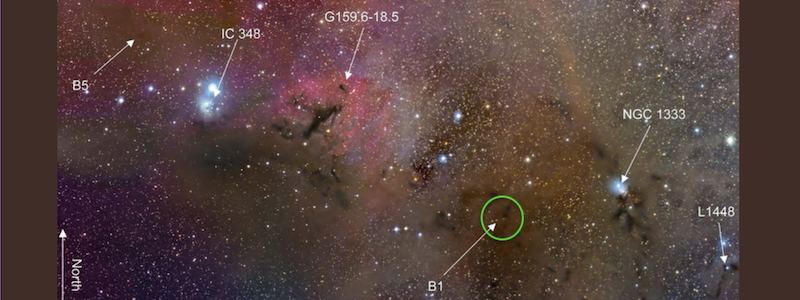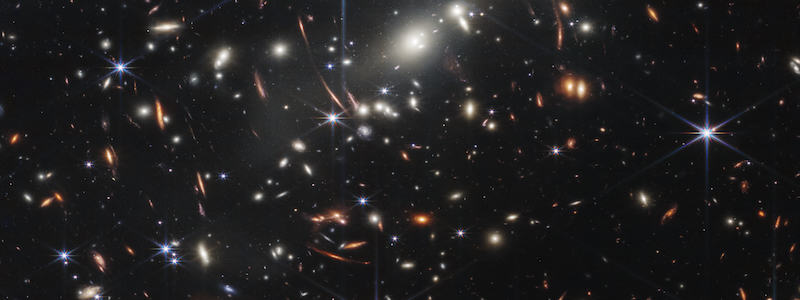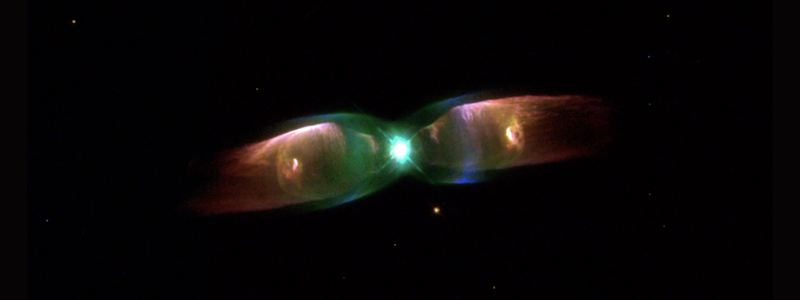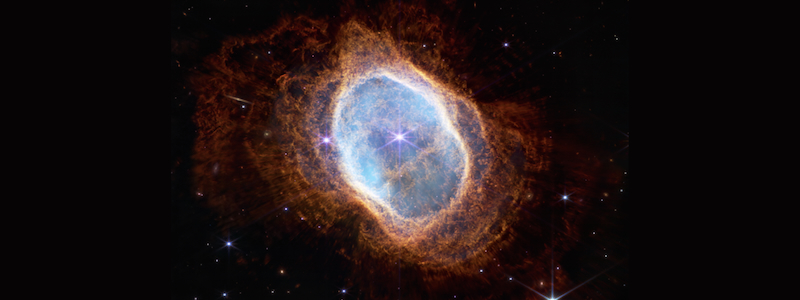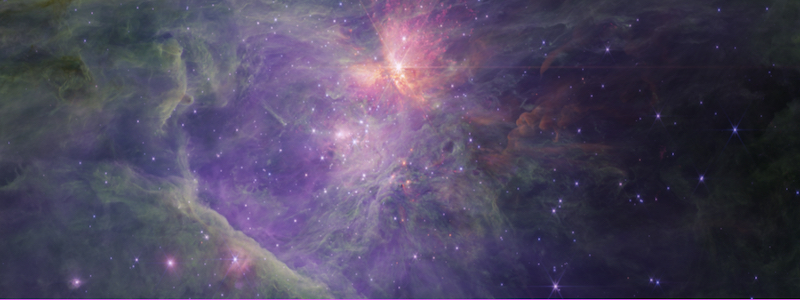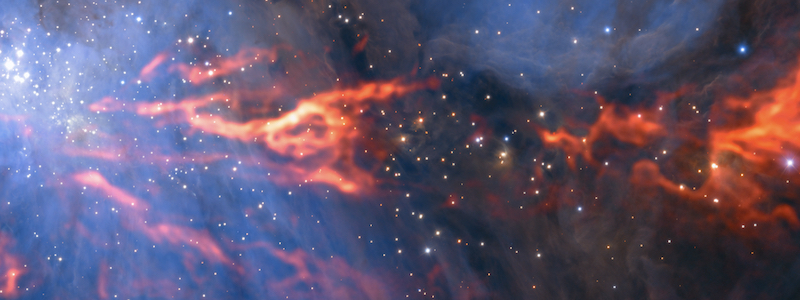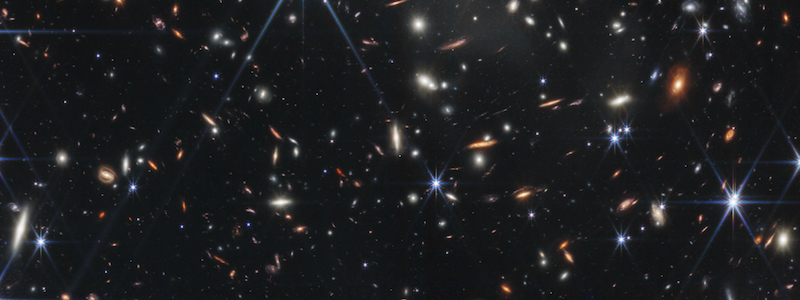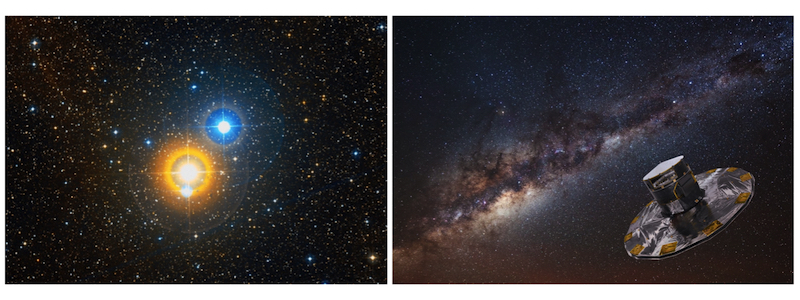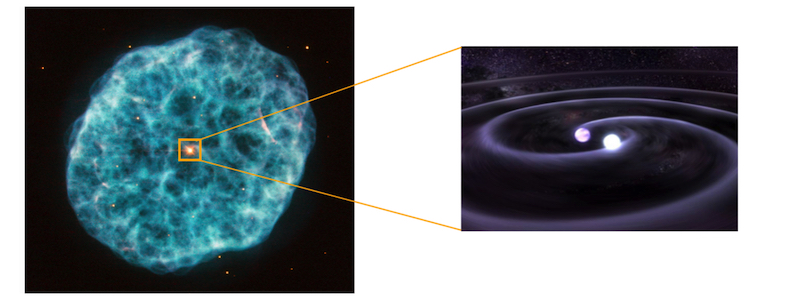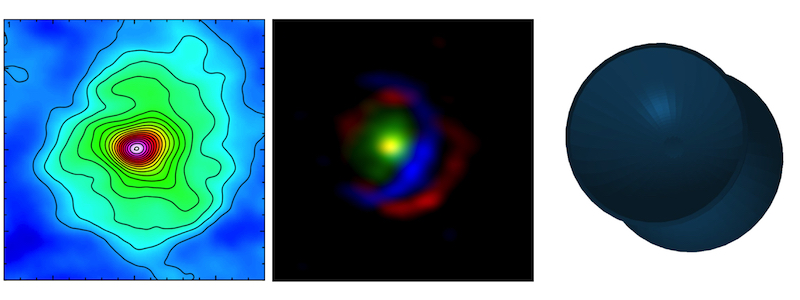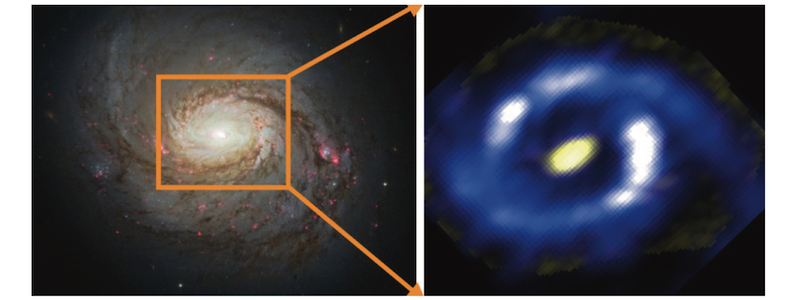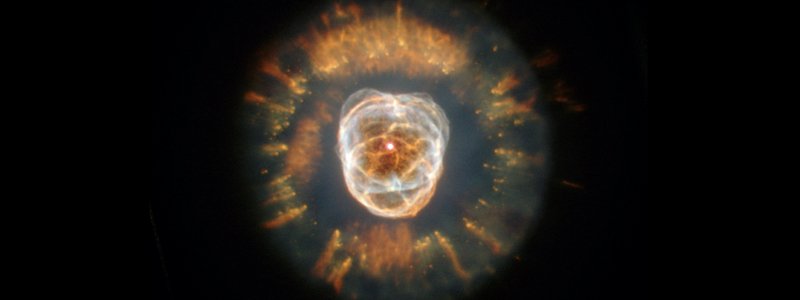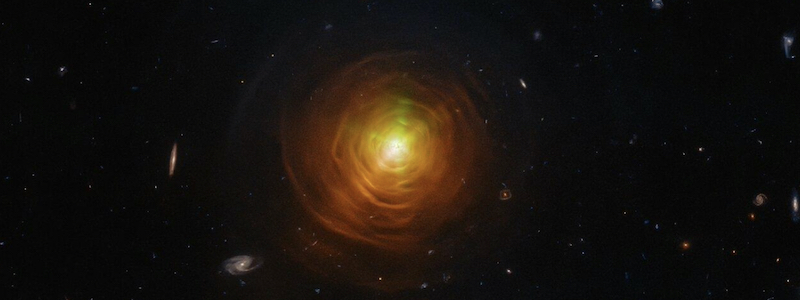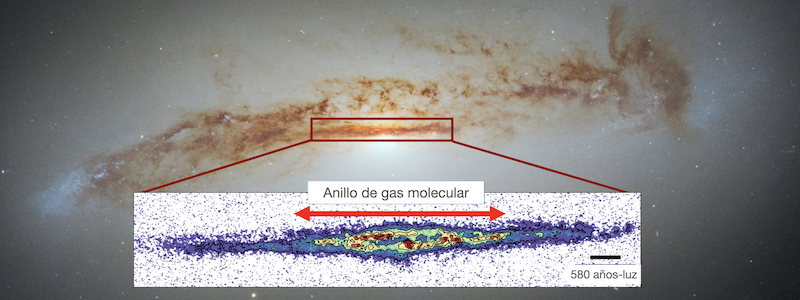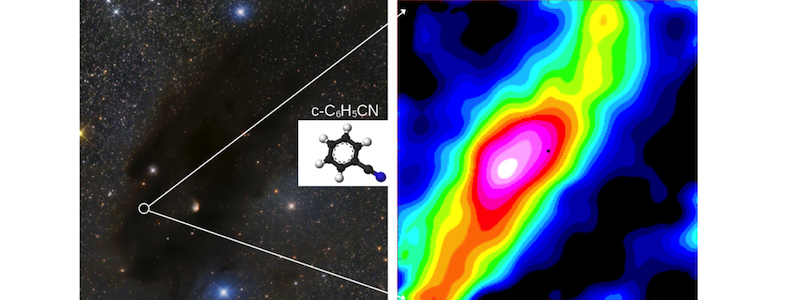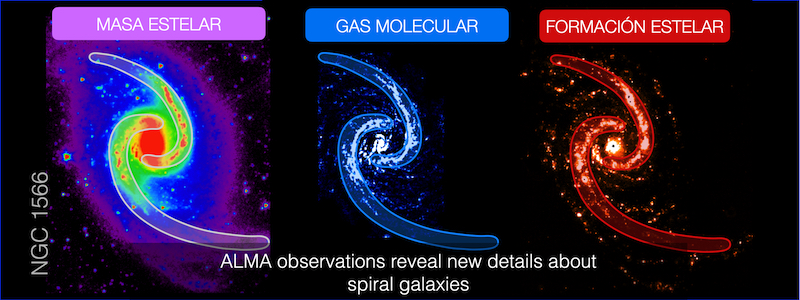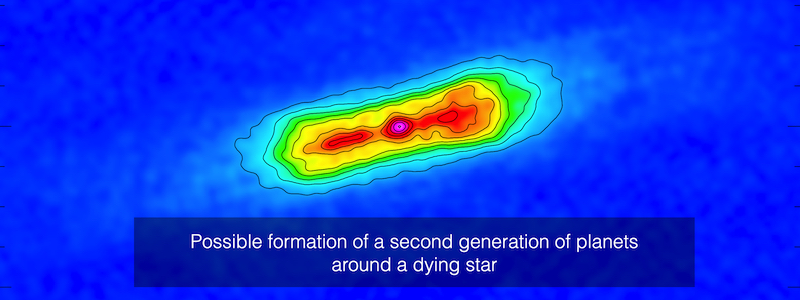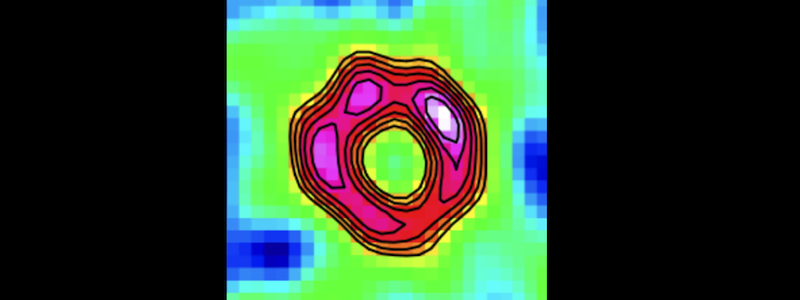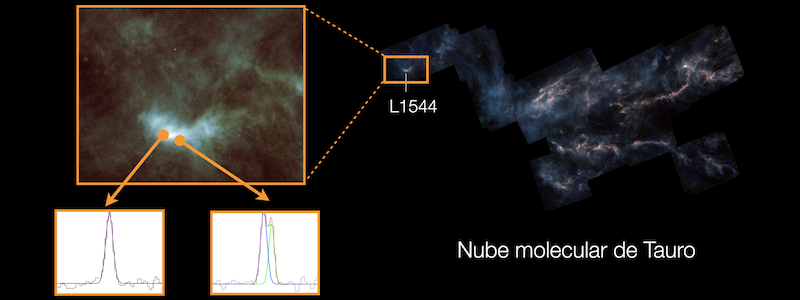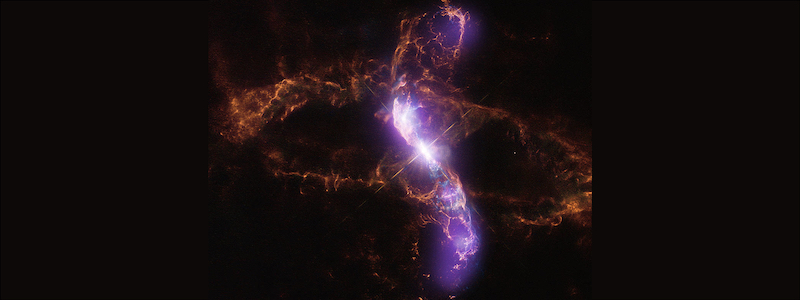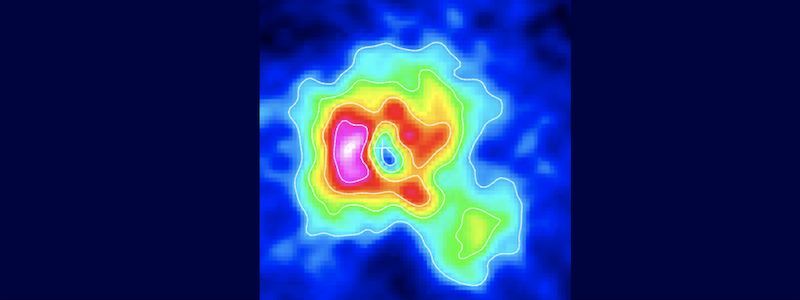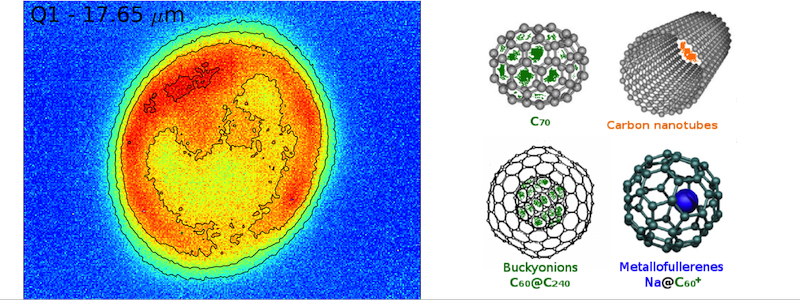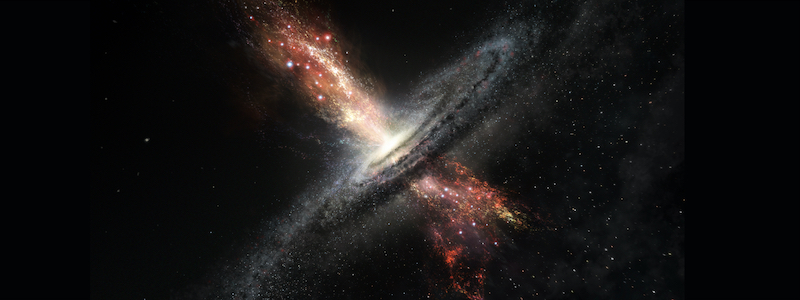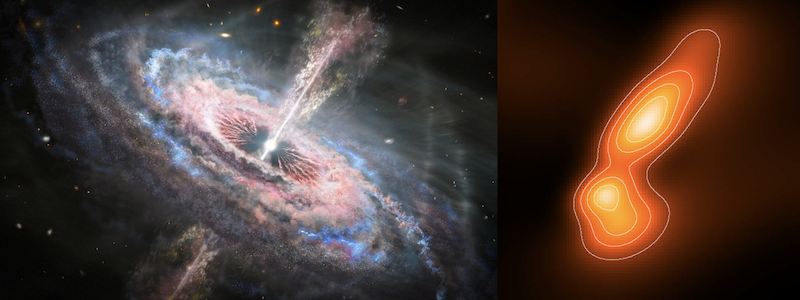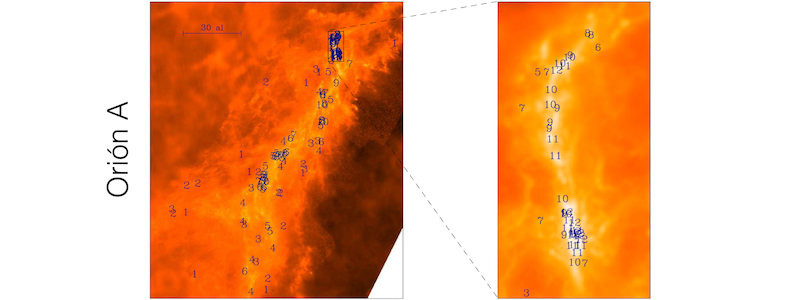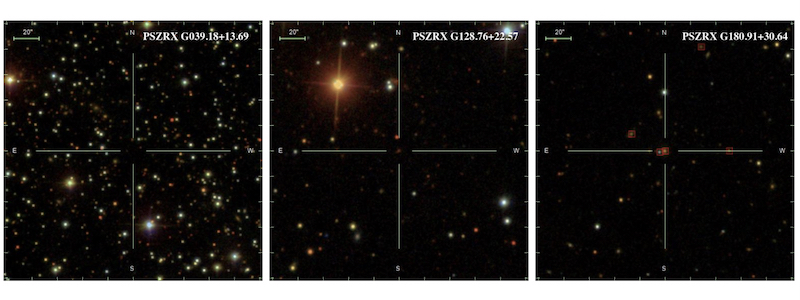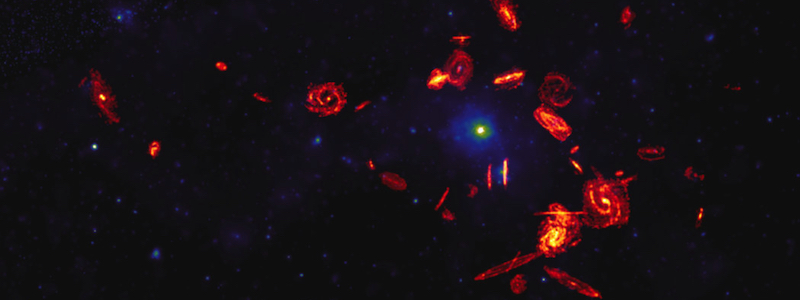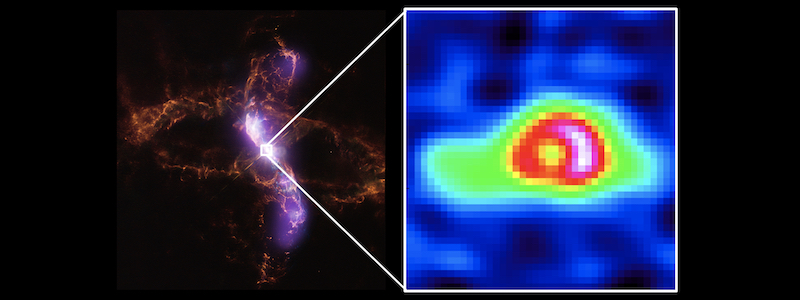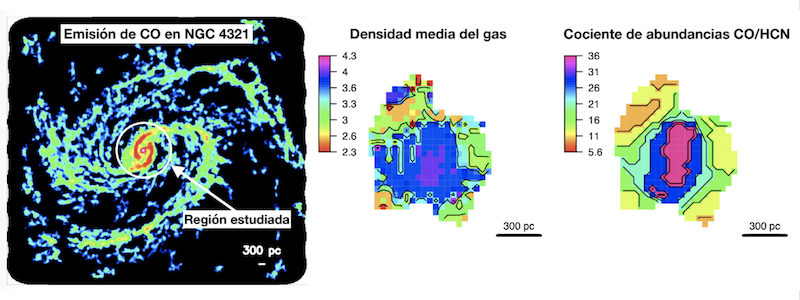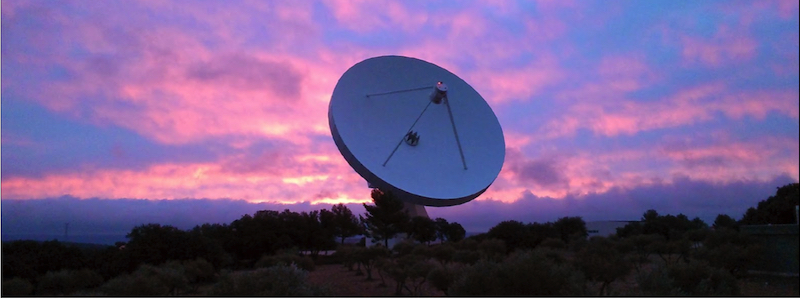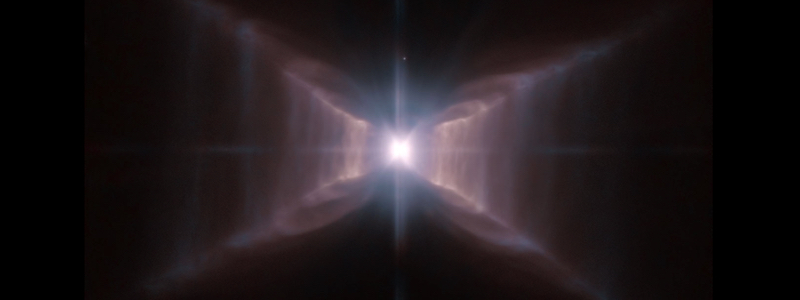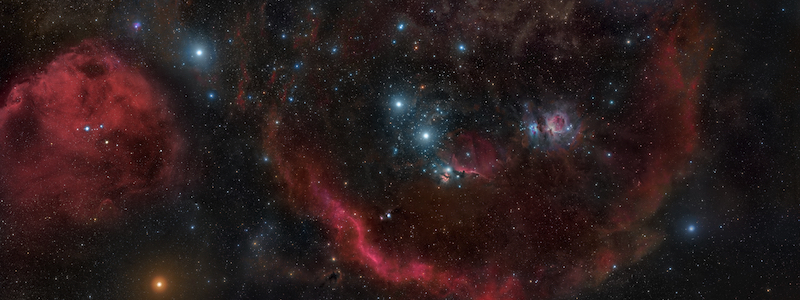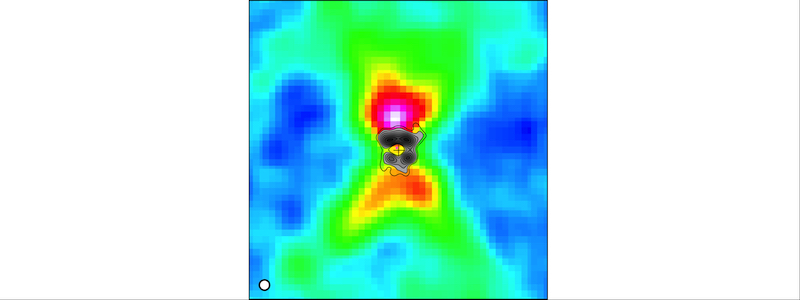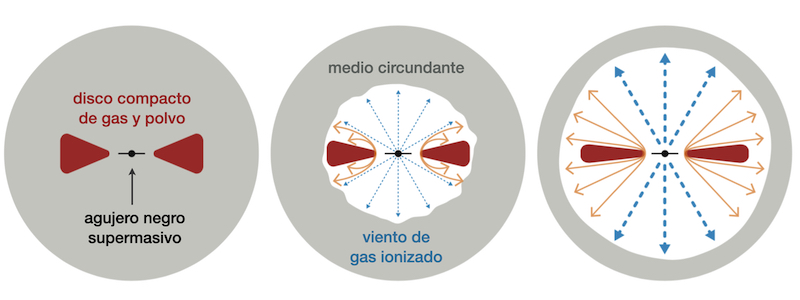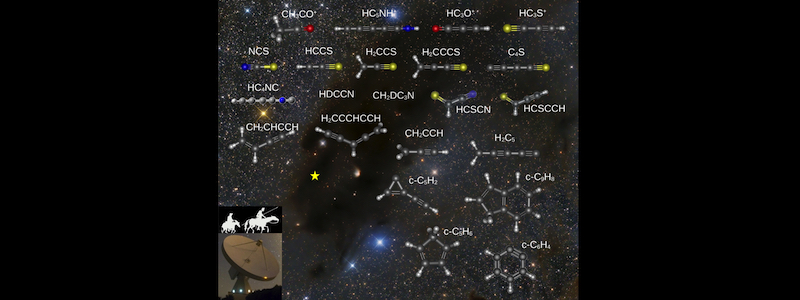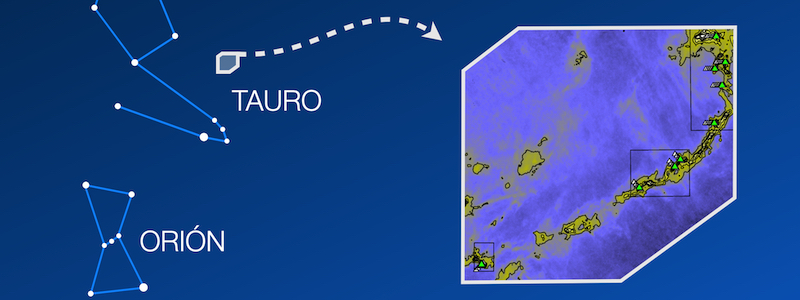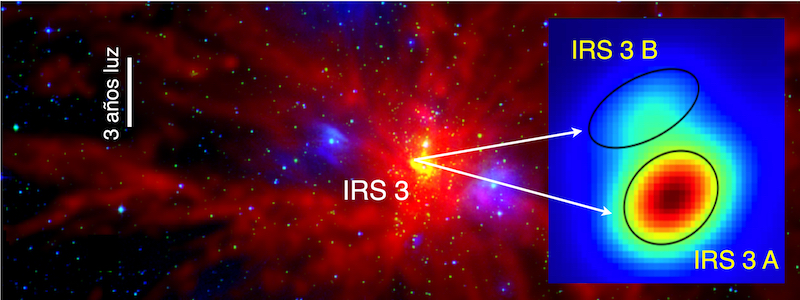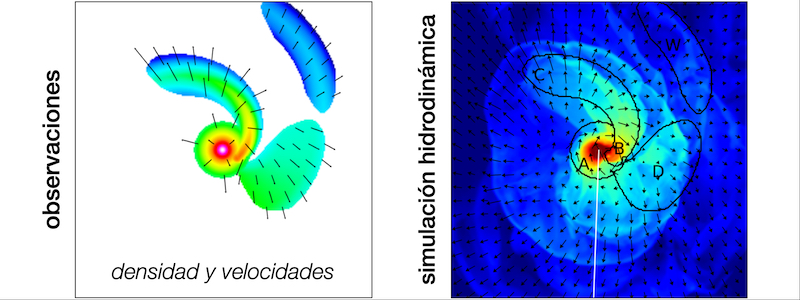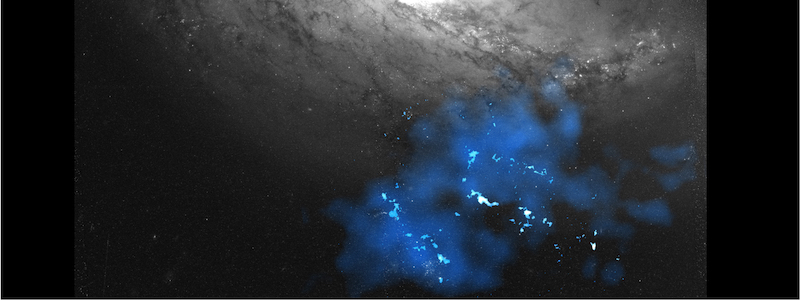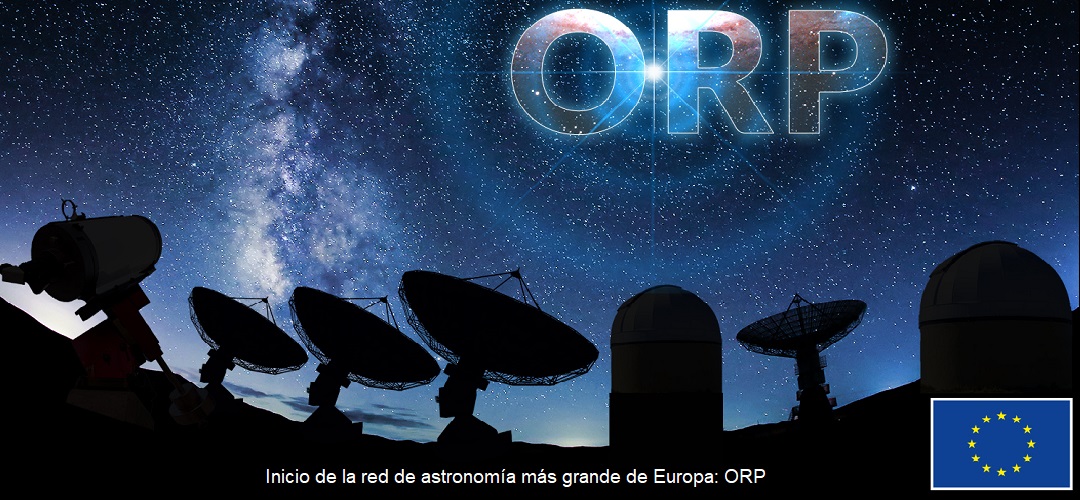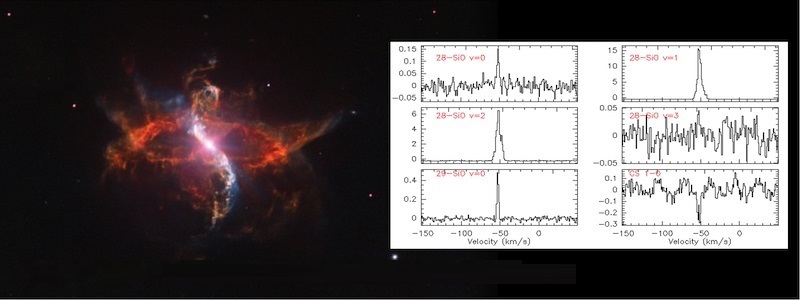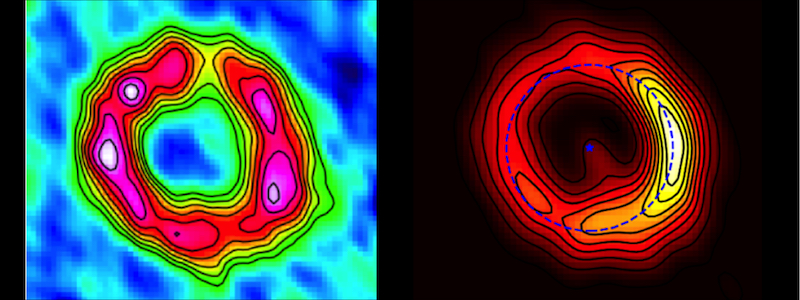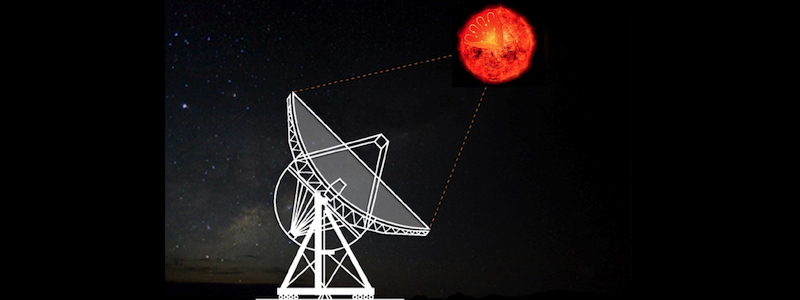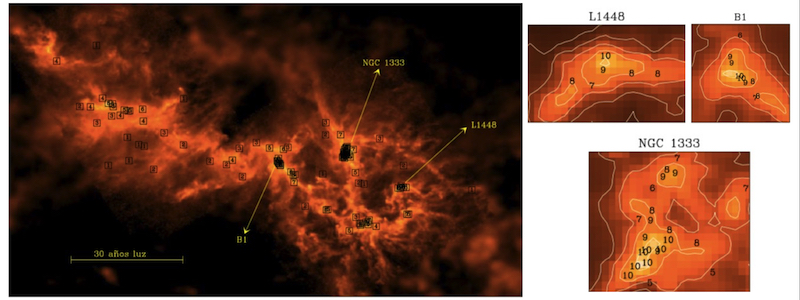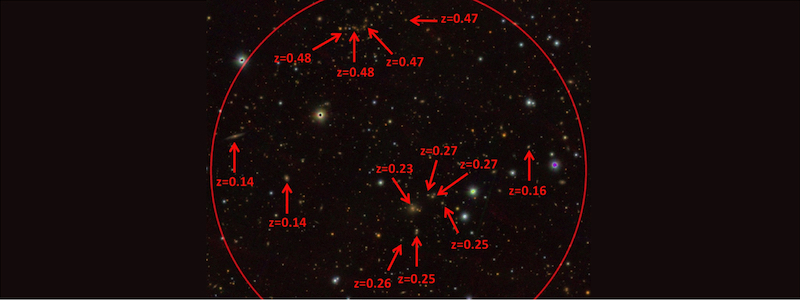News highlights
Chemical disequilibrium as a tracer of the evolution of star-forming regions
Hot corinos are regions of the interstellar medium where Sun-like stars are born. They have low temperatures and high densities, as well as a rich chemistry. Their study allows us to understand how molecules form in the early stages of star formation and how they evolve over millions of years.
Webb Space Telescope finds primordial supermassive black hole
Since its launch in 2021, the James Webb Space Telescope (JWST) has been delighting us with wonderful astronomical images. One of these, of the SMACS 0723 galaxy cluster, is the deepest image ever taken in the infrared range of the electromagnetic spectrum.
New ALMA data unveil the formation mechanism of the Butterfly Wings Nebula
Planetary nebulae are among the most fascinating objects in the sky. They are clouds of gas and dust formed as a result of the intense mass losses that solar-type stars undergo in the last stages of their lives. Part of their interest is due to the variety of shapes and structures that characterize these nebulae, sometimes of great geometric complexity, which makes many of them receive the most varied nicknames.
Observing quasars to study black holes and our planet
Quasars are among the most fascinating objects in the universe. These enormous galaxies host supermassive black holes that, by devouring matter, generate extreme energy. In this process, part of the material forms bright jets that travel almost at the speed of light, reaching distances much greater than the galaxies that contain them. Their intense brightness and remoteness make quasars ideal reference points for practical applications such as geodesy, which studies the shape and movements of the Earth.
The complexity of some planetary nebulae is due to symbiotic stars
Planetary nebulae are among the most spectacular structures in our galaxy. Despite their name, they are not directly related to planets, but correspond to the final stages in the life of stars similar to the Sun. Planetary nebulae have varied structures, from spheroidal to "hourglass" shapes. Although the mechanisms that give rise to these shapes are unknown in detail, in recent years these processes have been linked to the presence of two or more stars.
Properties of the densest and coldest gas in galaxies revealed
Revealing some of the properties of the densest and coldest gas in galaxies.
Galaxies are fundamental building blocks of the universe. Understanding their formation and evolution is therefore one of the great challenges of modern astrophysics. To do so, it is essential to study the interstellar medium and how stars form. From observations in our own galaxy, we know that stars are born in very cold and dense regions, where dust grains facilitate star formation processes.
The secrets of hydrogen sulfide in star formation
Studying the birth of stars and planets provides us with information not only about how the universe works, but also about the origin of our own planetary system and, by extension, our own life. We continue to make progress in this through astrochemistry, which analyzes the chemical processes that participate, with a key influence, in the processes of star formation. One specific tool is the study of deuteration: what percentage of the total amount of a certain molecule in the interstellar medium (such as water or hydrogen sulfide) has replaced at least one of its hydrogen atoms with its isotope, a deuterium atom (which has an extra neutron in its nucleus). The deuteration of different molecules provides very valuable information about the physical conditions of the environment and the evolutionary stage of the pre-stellar object considered.
What hides behind the Orion Nebula
The Orion Nebula is a familiar object to astronomy fans. It is the result of the birth of several thousand stars in the last two million years, and is easy to observe with a small telescope. To understand how this star cluster was formed, it is necessary to see the stars that are currently being born behind the bright nebula, and for this an amateur telescope is no longer enough. We need to use the most powerful instrumentation available, such as the ALMA interferometer, in the Atacama Desert in Chile.
A catalogue of galaxy clusters detected in X-rays
Galaxy clusters are huge cosmic structures made up of hundreds or thousands of galaxies that are gravitationally bound. Although the space between galaxies in a cluster may appear to be empty, it is actually filled with extremely hot gas. This diffuse gas emits highly energetic radiation that gives clusters an extensive, bright, and diffuse appearance when viewed in X-ray images.
Treasure hunt in the Gaia catalog
On many occasions we find two or more gravitationally linked stars in the Galaxy, what we know as multiple star systems. Double or binary systems are the most abundant and are a primary source of information in astrophysics, as they allow us to calculate the mass of their components.
On the hunt for binary stars to explain the fascinating morphology of planetary nebulae
About 90% of all stars in the universe will go through the planetary nebula phase before ending their lives as white dwarfs. The Sun will most likely be one of them. Planetary nebulae are among the most beautiful and amazing phenomena in the universe and have fascinated astronomers for decades. Of the more than 3,000 that we know of in our galaxy, the Milky Way, only 20% have spherical shapes. The rest show varied morphologies, far from spherical, such as bipolar or elliptical, and often display other complex structures. Understanding how exactly these diverse structures are formed is one of the main challenges of contemporary astronomy. Currently, there is a consensus in the scientific community that binary stars (systems of two stars that are gravitationally bound) could play a fundamental role in the formation of these stellar twilights.
A peculiar structure has been discovered in the nebula of the binary star 89 Herculis
At the end of their lives, stars like our Sun eject most of their mass, thus reducing their size and becoming extremely hot. The ejected material, composed of gas and dust, forms an expanding nebula around the star. If the star belongs to a binary system, the companion star could attract some of the ejected material, causing it to rotate and thus creating a stable nebular disk. These disks typically have a mass thousands of times greater than that of Earth and are the origin of material jets that escape into space.
ALMA studies the cradle of stars in other galaxies
Stars are born in clouds of molecular gas that populate galaxies. An international team led by astronomers from the National Astronomical Observatory (OAN, IGN) has investigated with the ALMA interferometer how gas density determines its ability to form stars.
The mystery of binary planetary nebulae: Weighing clouds in space
Stars like the Sun become giants at the end of their lives and eject their atmosphere, forming a planetary nebula. If they have a companion star nearby, as they become giants they surround it, sharing with it the envelope, which is ejected by orbital friction. The result of this ejection would be what we see as a planetary nebula. At least 25% of planetary nebulae are thought to be of this type, but how the ejection occurs is unknown, as theoretical models are unable to explain the ejection of the full mass of the envelope.
Magnesium in the envelope of CW Leonis: micronutrients in a dying star
Located about 400 light-years away, CW Leonis is a dying star in the red giant stage. At this stage, the outer layers of the star are ejected into space and the star is covered by dense clouds of gas and dust. This beautiful envelope around CW Leonis is known as IRC+10216.
IGN astronomers analyse the connection between black holes and galaxies with ALMA
The presence of supermassive black holes at the center of most galaxies is a firmly established fact based on both theoretical and observational arguments. In a significant percentage of galaxies, referred to as "active," black holes are fueled by the accretion of gas. As gas falls towards the central singularity, it can emit a substantial amount of energy and jets of matter that travel at high speeds. Eventually, these jets interact with the gas in the galaxy's disk, potentially expelling it outward.
First map of a cyclic molecule in a cold cloud in Taurus
Located in the constellation Taurus, about 500 light-years away, the interstellar cloud TMC-1 is one of the closest where we can observe the formation of stars like our Sun. Surprisingly, the nebula has a very large variety of molecules, many of which have been discovered by a team of scientists from the National Astronomical Observatory (OAN, IGN) and the CSIC, using the IGN's 40-metre radio telescope at the Yebes Observatory. Knowing the chemical composition of these star-forming regions can help us understand the development of life in a future planetary system.
ALMA observations yield new insights into spiral galaxies
Galaxies like our own Milky Way are flat like a disc and are characterised by their spiral structure. The spiral arms stand out because they contain young, luminous stars,a product of the intense star formation that occurs in them. Traditionally, this profusion of young stars is attributed to the compression of gas in the arms, which is expected to form new stars more efficiently than others regions. However, new ALMA observations challenge this theory by revealing a lower than expected star formation efficiency in the spiral arms.
Possible formation of a second generation of planets around a dying star
At the end of their lives, stars tend to lose mass and, being much older than our Sun, expel most of their original mass. This material forms vast, diffuse nebulae around the star, which are made up of gas and dust grains. Normally, these nebulae are expanding, moving away from the star at speeds of about fifty thousand kilometres per hour. But sometimes a part of this large amount of matter, equivalent to about a thousand times the mass of the Earth, is left rotating around the star from which it came. This is because the mass-losing star is actually part of a binary system: the companion star attracts the ejected material and rotates it, until it reaches a stable orbit and takes the form of a disc.
Discovery of hydrogen sulfide rings in protoplanetary discs
Planets are born in discs of gas and dust around young stars. In these discs, called protoplanetary discs, a set of physical and chemical phenomena compete with each other to sculpt the final shape of the planetary system. By studying these objects, we can obtain fundamental information about the processes that lead to the formation of planets like the Earth. The development of state-of-the-art observatories such as ALMA and NOEMA has provided the sensitivity and spatial resolution needed to examine these exciting objects, for example by mapping the distribution of dust and different chemical compounds.
New radioastronomical observations reveal the structure of filaments where stars are born
The dense clouds of the interstellar medium, largely composed of molecular gas, have a very filamentary structure. By studying the motion of this gas, astronomers at the National Astronomical Observatory (NAO) discovered a few years ago that these filaments are in turn composed of finer fibers. And in these fibers are located small particularly dense areas: they are the "pre-stellar cores", regions that, by the mere effect of gravity, are collapsing on themselves to form a star with its corresponding planetary system. Such pre-stellar condensations, which do not yet contain any well-defined central object that can be qualified as a "protostar", are particularly interesting for understanding the physical mechanisms that dominate the first phases of star formation.
VLBI observations of the symbiotic system R Aquarii
Binary star systems are unique astrophysical laboratories: in them we find extreme physical phenomena, from supernova explosions to the emission of gravitational waves. Binary systems that include an asymptotic giant branch (AGB) star are particularly interesting because both stars can interact. AGB stars are already old stars that lose copious amounts of mass. The ejected mass gives rise to molecular gas and dust nebulae, which will become planetary nebulae when the central star becomes hot enough to dissociate the molecules and ionize the gas-phase atoms.
Sulphur as an astronomical clock
The hot corinos, of which only a dozen are known, are regions that arise during the formation of solar-type protostars. One way to understand the dynamics and evolution of the early stages of star formation is by studying their chemistry. When a star begins to form, the temperature of the region is low and the density high, so gaseous molecules adhere to the surface of the dust grains present. As the collapse of the pre-stellar core proceeds, the temperature increases and the molecules pass directly into the gaseous state. This makes hot corinos chemically rich regions.
Fullerenes in circumstellar envelopes
C60 and C70 fullerenes are molecules consisting of 60 and 70 carbon atoms, respectively. These molecules have attracted the attention of scientists since their discovery in the laboratory around 1985, due to their various applications in photoelectric cells or medicine. From the astronomical point of view, they are capable of explaining certain spectral bands observed in the interstellar medium, but not identified. Their presence in space was the subject of heated debate until the first firm detection of C60 and C70 in the planetary nebula Tc 1 by the Spitzer infrared space telescope.
New tool for the study of the first galaxies
However, one of the greatest challenges of extragalactic astrophysics is to understand the processes that operated in the first galaxies. After the Big Bang, the universe was so hot and dense that atoms could not exist except split into their constituents, forming a plasma. As the universe expanded, its density and temperature decreased until electrons and protons could recombine to form the first hydrogen atoms. The first stars, in turn, re-ionized the hydrogen atoms with their intense radiation. We know this period as the epoch of reionization.
New method for ultra-precise imaging of active galaxies
Active galaxies are characterised by a very bright nucleus with a supermassive black hole that attracts matter around it. Due to the magnetic fields present, some of the energy from the accretion is transferred into particles that are ejected out at almost the speed of light, forming large, very bright jets that can reach sizes larger than the galaxies that host them. Because of their brightness and the great distance at which they are located, these galaxies are not only used to extend our knowledge of them, but also serve as cosmic beacons for defining spatial reference systems.
A new method unveils the properties of three molecular clouds
Molecular clouds are the largest and most massive objects in our galaxy. They are composed of diffuse material that sometimes condenses under the force of its own gravity and produces new generations of stars. Understanding the internal structure of clouds and how they form stars is of great astronomical interest, although it involves many technical difficulties. Molecular clouds are so cold that they are only detectable using powerful radio telescopes, and these usually consist of single-pixel detectors. The traditional technique for observing molecular clouds is to sweep the radio telescope so that the receiver pixel sweeps across the entire surface of the cloud. This allows a detailed image to be obtained, although it entails a high cost in telescope time. Therefore, the number of molecular clouds characterized to date is extremely limited.
Identification of new galaxy clusters
Galaxy clusters are huge cosmic structures composed of hundreds or thousands of galaxies, hot ionised gas covering the space between them, and a large amount of dark matter, which we cannot observe directly but which we know makes up 85% of the total mass of the cluster. Thanks to their properties, clusters provide us with valuable information about the physical phenomena involved in the formation of cosmic structures, as well as about the nature of dark matter and dark energy.
Star formation under extreme conditions unveiled in the Virgo cluster
How do galaxies evolve? This is one of the biggest questions in all of science. Galaxies are large collections of stars that are born from huge collapsing clouds of cold molecular gas. The physical processes that govern the life cycle and evolution of these complex systems are closely related to the region of space in which they reside, the galaxy environment.
Symbiotic star R Aquarii observed in its most critical phase
Symbiotic star systems are made up of two stars that are very close to each other. The first of these is usually a red giant star at a stage in its life when it loses much of its material, as will happen to our Sun in several billion years. Due to gravitational attraction, the ejected material falls onto its companion, which is usually a very hot white dwarf star.
ALMA reveals the properties of dense molecular gas in nearby galaxies
Stars are born in the cold clouds of molecular gas and dust that populate galaxies. A team led by National Astronomical Observatory (OAN, IGN) astronomers Axel García Rodríguez and Antonio Usero has used the powerful ALMA interferometer to investigate one of the great unknowns of this process: what is the relationship between the properties of clouds and their ability to form stars?
Astrochemistry and the 40 m Yebes radio telescope: record-breaking numbers
Molecules play a key role in the processes of galaxy and star formation. Molecular gas dominates the densest regions of the interstellar medium, where matter undergoes a drastic transformation from cold, dark clouds to form stars and planetary systems. Astrochemistry, or molecular astrophysics, allows us to better understand this process by studying molecules detected in space.
New data on the chemical composition of evolved double stars
Most stars in the universe live their lives in pairs. Some of these binary systems, as one of the stars ages, grows older and ejects its crust, show a noticeable excess of infrared radiation. This is due to dust and gas orbiting both stars, confined to a disc in the orbital plane of the system, as well as jets of material escaping from the disc. Some of these systems have very massive jets, while in others, most of the mass is in the rotating disc. The chemical processes that take place in such sources have been largely unknown until now.
The chemistry of star birth
The study of the chemical processes that occur in the early stages of star and planet formation is one of the leading fields of astrophysics today, and one of the main fields of work of astronomers at the Observatorio Astronómico Nacional (OAN-IGN). The aim is to study how molecules are formed and destroyed in this environment, as well as the role that these molecules play in the formation of the star itself. This also provides us with information about the chemistry that planets can inherit and about the history of the elements and molecules that form the basis of life.
ALMA reveals a rotating disc and bipolar jet in an evolved binary star
One of the most enigmatic aspects of the evolutionary stages is the appearance of mass loss phenomena preferentially in one direction. These bipolar jets give rise to the formation of planetary nebulae with complex structures and their origin is one of the most important fields of work of the astronomers of the National Astronomical Observatory (IGN). There is now a growing consensus that bipolarity must be associated with binary stellar systems, but the detailed explanation of these phenomena is far from being known.
Active galaxies: an intelligent design to feed the central monster
García-Burillo's team's observations have made it possible to demonstrate, for the first time, that the distribution of gas in the circum-nuclear regions of galaxies faithfully reflects a very sophisticated design that achieves self-regulation of nuclear activity. All these results have been published in two recent articles in the prestigious journal Astronomy & Astrophysics as part of the GATOS (Galaxy Activity Torus and Outflow Survey) project.
IGN astronomers, using the Yebes Radio Telescope, have already discovered 22 new molecules in space new molecules in space
One of the ways to understand the evolution of pre-stellar nuclei is through deuterated molecules. A team led by astronomer Gisela Bañó Esplugues from the Observatorio Astronómico Nacional has studied the evolution of a sample of pre-stellar nuclei in different regions of the sky.
Deuterium reveals new details of star formation
One of the primary goals of current astrophysics is to determine the chemical composition of gas in star-forming regions, in particular that of molecules in space. composition of the gas in star-forming regions, in particular that of complex organic molecules, which can be complex organic molecules, which could be connected to the development of life in a future planetary system. In recent years, it has been discovered that organic molecules are not only found in active star-forming regions only found in active star-forming regions, but also in dense and frigid pre-stellar cores. cold, dense pre-stellar cores, where a protostar has not yet formed.
The birth of a massive star
Of the hundreds of billions of stars in the Milky Way, only one in a hundred has a mass equal to or greater than ten times the mass of the Sun - this is called a massive star. These are the stars that determine the evolution of galaxies.
Symbiotic stars: the life of R Aquarii
A symbiotic star system is a pair of stars orbiting each other; they are so close that they interact and exchange material with each other, while at the same time enhancing the system's ability to eject material outwards.
ALMA observes the birth of a galaxy
Collisions between galaxies are spectacular processes, cosmic fireworks in which stars rearrange themselves into unique shapes and gas creates vast tails. ALMA has witnessed the formation of a new galaxy in such a collision.
Launch of Europe's largest astronomy network: ORP
The IGN, through the Yebes Observatory and the Institute of Millimetre Radio Astronomy, has been part of the radio wave domain (RadioNet) since 2008. The recent merger of OPTICON and RadioNet has resulted in the largest collaborative ground-based astronomy network in Europe: ORP.
Census of SiO masers in symbiotic stars
Molecular clouds are huge concentrations of gas where the process of star formation is currently taking place. These clouds are reminiscent of the Earth's atmosphere in their irregular appearance, but their internal physics is much more complex due to the combined action of the force of gravity, magnetic fields, and the turbulent motions of the gas.
Detecting forming planets in young stars
Protoplanetary discs are structures surrounding young stars, composed of gas and dust, inside which planets form. By studying protoplanetary discs we aim to understand how planets form and what the evolutionary history of our solar system was.
New observations of red giant stars with VLBI
At the end of their lives, intermediate-mass stars, such as our Sun, go through the so-called red giant phase, when they expel most of their mass into space in an envelope of gas and dust. After undergoing drastic changes in morphology and chemistry in this envelope, red giants eventually become planetary nebulae.
A new technique to study star-forming regions
Molecular clouds are huge concentrations of gas where the process of star formation is currently taking place. These clouds are reminiscent of the Earth's atmosphere in their irregular appearance, but their internal physics is much more complex due to the combined action of the force of gravity, magnetic fields, and the turbulent motions of the gas.
New distance estimates to remote galaxies
Due to the expansion of the universe, galaxies are moving away from us at a faster rate the further away they are. This distancing causes the light emitted by these galaxies to reach us at lower frequencies, analogous to what happens when we hear the siren of a receding ambulance.
News highlights
Observing quasars to study black holes and our planet
Quasars are among the most fascinating objects in the universe. These enormous galaxies host supermassive black holes that, by devouring matter, generate extreme energy. In this process, part of the material forms bright jets that travel almost at the speed of light, reaching distances much greater than the galaxies that contain them. Their intense brightness and remoteness make quasars ideal reference points for practical applications such as geodesy, which studies the shape and movements of the Earth.
The complexity of some planetary nebulae is due to symbiotic stars
Planetary nebulae are among the most spectacular structures in our galaxy. Despite their name, they are not directly related to planets, but correspond to the final stages in the life of stars similar to the Sun. Planetary nebulae have varied structures, from spheroidal to "hourglass" shapes. Although the mechanisms that give rise to these shapes are unknown in detail, in recent years these processes have been linked to the presence of two or more stars.
Properties of the densest and coldest gas in galaxies revealed
Revealing some of the properties of the densest and coldest gas in galaxies.
Galaxies are fundamental building blocks of the universe. Understanding their formation and evolution is therefore one of the great challenges of modern astrophysics. To do so, it is essential to study the interstellar medium and how stars form. From observations in our own galaxy, we know that stars are born in very cold and dense regions, where dust grains facilitate star formation processes.
The secrets of hydrogen sulfide in star formation
Studying the birth of stars and planets provides us with information not only about how the universe works, but also about the origin of our own planetary system and, by extension, our own life. We continue to make progress in this through astrochemistry, which analyzes the chemical processes that participate, with a key influence, in the processes of star formation. One specific tool is the study of deuteration: what percentage of the total amount of a certain molecule in the interstellar medium (such as water or hydrogen sulfide) has replaced at least one of its hydrogen atoms with its isotope, a deuterium atom (which has an extra neutron in its nucleus). The deuteration of different molecules provides very valuable information about the physical conditions of the environment and the evolutionary stage of the pre-stellar object considered.
What hides behind the Orion Nebula
The Orion Nebula is a familiar object to astronomy fans. It is the result of the birth of several thousand stars in the last two million years, and is easy to observe with a small telescope. To understand how this star cluster was formed, it is necessary to see the stars that are currently being born behind the bright nebula, and for this an amateur telescope is no longer enough. We need to use the most powerful instrumentation available, such as the ALMA interferometer, in the Atacama Desert in Chile.
A catalogue of galaxy clusters detected in X-rays
Galaxy clusters are huge cosmic structures made up of hundreds or thousands of galaxies that are gravitationally bound. Although the space between galaxies in a cluster may appear to be empty, it is actually filled with extremely hot gas. This diffuse gas emits highly energetic radiation that gives clusters an extensive, bright, and diffuse appearance when viewed in X-ray images.
Treasure hunt in the Gaia catalog
On many occasions we find two or more gravitationally linked stars in the Galaxy, what we know as multiple star systems. Double or binary systems are the most abundant and are a primary source of information in astrophysics, as they allow us to calculate the mass of their components.
On the hunt for binary stars to explain the fascinating morphology of planetary nebulae
About 90% of all stars in the universe will go through the planetary nebula phase before ending their lives as white dwarfs. The Sun will most likely be one of them. Planetary nebulae are among the most beautiful and amazing phenomena in the universe and have fascinated astronomers for decades. Of the more than 3,000 that we know of in our galaxy, the Milky Way, only 20% have spherical shapes. The rest show varied morphologies, far from spherical, such as bipolar or elliptical, and often display other complex structures. Understanding how exactly these diverse structures are formed is one of the main challenges of contemporary astronomy. Currently, there is a consensus in the scientific community that binary stars (systems of two stars that are gravitationally bound) could play a fundamental role in the formation of these stellar twilights.
A peculiar structure has been discovered in the nebula of the binary star 89 Herculis
At the end of their lives, stars like our Sun eject most of their mass, thus reducing their size and becoming extremely hot. The ejected material, composed of gas and dust, forms an expanding nebula around the star. If the star belongs to a binary system, the companion star could attract some of the ejected material, causing it to rotate and thus creating a stable nebular disk. These disks typically have a mass thousands of times greater than that of Earth and are the origin of material jets that escape into space.
ALMA studies the cradle of stars in other galaxies
Stars are born in clouds of molecular gas that populate galaxies. An international team led by astronomers from the National Astronomical Observatory (OAN, IGN) has investigated with the ALMA interferometer how gas density determines its ability to form stars.
The mystery of binary planetary nebulae: Weighing clouds in space
Stars like the Sun become giants at the end of their lives and eject their atmosphere, forming a planetary nebula. If they have a companion star nearby, as they become giants they surround it, sharing with it the envelope, which is ejected by orbital friction. The result of this ejection would be what we see as a planetary nebula. At least 25% of planetary nebulae are thought to be of this type, but how the ejection occurs is unknown, as theoretical models are unable to explain the ejection of the full mass of the envelope.
Magnesium in the envelope of CW Leonis: micronutrients in a dying star
Located about 400 light-years away, CW Leonis is a dying star in the red giant stage. At this stage, the outer layers of the star are ejected into space and the star is covered by dense clouds of gas and dust. This beautiful envelope around CW Leonis is known as IRC+10216.
IGN astronomers analyse the connection between black holes and galaxies with ALMA
The presence of supermassive black holes at the center of most galaxies is a firmly established fact based on both theoretical and observational arguments. In a significant percentage of galaxies, referred to as "active," black holes are fueled by the accretion of gas. As gas falls towards the central singularity, it can emit a substantial amount of energy and jets of matter that travel at high speeds. Eventually, these jets interact with the gas in the galaxy's disk, potentially expelling it outward.
First map of a cyclic molecule in a cold cloud in Taurus
Located in the constellation Taurus, about 500 light-years away, the interstellar cloud TMC-1 is one of the closest where we can observe the formation of stars like our Sun. Surprisingly, the nebula has a very large variety of molecules, many of which have been discovered by a team of scientists from the National Astronomical Observatory (OAN, IGN) and the CSIC, using the IGN's 40-metre radio telescope at the Yebes Observatory. Knowing the chemical composition of these star-forming regions can help us understand the development of life in a future planetary system.
ALMA observations yield new insights into spiral galaxies
Galaxies like our own Milky Way are flat like a disc and are characterised by their spiral structure. The spiral arms stand out because they contain young, luminous stars,a product of the intense star formation that occurs in them. Traditionally, this profusion of young stars is attributed to the compression of gas in the arms, which is expected to form new stars more efficiently than others regions. However, new ALMA observations challenge this theory by revealing a lower than expected star formation efficiency in the spiral arms.
Possible formation of a second generation of planets around a dying star
At the end of their lives, stars tend to lose mass and, being much older than our Sun, expel most of their original mass. This material forms vast, diffuse nebulae around the star, which are made up of gas and dust grains. Normally, these nebulae are expanding, moving away from the star at speeds of about fifty thousand kilometres per hour. But sometimes a part of this large amount of matter, equivalent to about a thousand times the mass of the Earth, is left rotating around the star from which it came. This is because the mass-losing star is actually part of a binary system: the companion star attracts the ejected material and rotates it, until it reaches a stable orbit and takes the form of a disc.
Discovery of hydrogen sulfide rings in protoplanetary discs
Planets are born in discs of gas and dust around young stars. In these discs, called protoplanetary discs, a set of physical and chemical phenomena compete with each other to sculpt the final shape of the planetary system. By studying these objects, we can obtain fundamental information about the processes that lead to the formation of planets like the Earth. The development of state-of-the-art observatories such as ALMA and NOEMA has provided the sensitivity and spatial resolution needed to examine these exciting objects, for example by mapping the distribution of dust and different chemical compounds.
New radioastronomical observations reveal the structure of filaments where stars are born
The dense clouds of the interstellar medium, largely composed of molecular gas, have a very filamentary structure. By studying the motion of this gas, astronomers at the National Astronomical Observatory (NAO) discovered a few years ago that these filaments are in turn composed of finer fibers. And in these fibers are located small particularly dense areas: they are the "pre-stellar cores", regions that, by the mere effect of gravity, are collapsing on themselves to form a star with its corresponding planetary system. Such pre-stellar condensations, which do not yet contain any well-defined central object that can be qualified as a "protostar", are particularly interesting for understanding the physical mechanisms that dominate the first phases of star formation.
VLBI observations of the symbiotic system R Aquarii
Binary star systems are unique astrophysical laboratories: in them we find extreme physical phenomena, from supernova explosions to the emission of gravitational waves. Binary systems that include an asymptotic giant branch (AGB) star are particularly interesting because both stars can interact. AGB stars are already old stars that lose copious amounts of mass. The ejected mass gives rise to molecular gas and dust nebulae, which will become planetary nebulae when the central star becomes hot enough to dissociate the molecules and ionize the gas-phase atoms.
Sulphur as an astronomical clock
The hot corinos, of which only a dozen are known, are regions that arise during the formation of solar-type protostars. One way to understand the dynamics and evolution of the early stages of star formation is by studying their chemistry. When a star begins to form, the temperature of the region is low and the density high, so gaseous molecules adhere to the surface of the dust grains present. As the collapse of the pre-stellar core proceeds, the temperature increases and the molecules pass directly into the gaseous state. This makes hot corinos chemically rich regions.
Fullerenes in circumstellar envelopes
C60 and C70 fullerenes are molecules consisting of 60 and 70 carbon atoms, respectively. These molecules have attracted the attention of scientists since their discovery in the laboratory around 1985, due to their various applications in photoelectric cells or medicine. From the astronomical point of view, they are capable of explaining certain spectral bands observed in the interstellar medium, but not identified. Their presence in space was the subject of heated debate until the first firm detection of C60 and C70 in the planetary nebula Tc 1 by the Spitzer infrared space telescope.
New tool for the study of the first galaxies
However, one of the greatest challenges of extragalactic astrophysics is to understand the processes that operated in the first galaxies. After the Big Bang, the universe was so hot and dense that atoms could not exist except split into their constituents, forming a plasma. As the universe expanded, its density and temperature decreased until electrons and protons could recombine to form the first hydrogen atoms. The first stars, in turn, re-ionized the hydrogen atoms with their intense radiation. We know this period as the epoch of reionization.
New method for ultra-precise imaging of active galaxies
Active galaxies are characterised by a very bright nucleus with a supermassive black hole that attracts matter around it. Due to the magnetic fields present, some of the energy from the accretion is transferred into particles that are ejected out at almost the speed of light, forming large, very bright jets that can reach sizes larger than the galaxies that host them. Because of their brightness and the great distance at which they are located, these galaxies are not only used to extend our knowledge of them, but also serve as cosmic beacons for defining spatial reference systems.
A new method unveils the properties of three molecular clouds
Molecular clouds are the largest and most massive objects in our galaxy. They are composed of diffuse material that sometimes condenses under the force of its own gravity and produces new generations of stars. Understanding the internal structure of clouds and how they form stars is of great astronomical interest, although it involves many technical difficulties. Molecular clouds are so cold that they are only detectable using powerful radio telescopes, and these usually consist of single-pixel detectors. The traditional technique for observing molecular clouds is to sweep the radio telescope so that the receiver pixel sweeps across the entire surface of the cloud. This allows a detailed image to be obtained, although it entails a high cost in telescope time. Therefore, the number of molecular clouds characterized to date is extremely limited.
Identification of new galaxy clusters
Galaxy clusters are huge cosmic structures composed of hundreds or thousands of galaxies, hot ionised gas covering the space between them, and a large amount of dark matter, which we cannot observe directly but which we know makes up 85% of the total mass of the cluster. Thanks to their properties, clusters provide us with valuable information about the physical phenomena involved in the formation of cosmic structures, as well as about the nature of dark matter and dark energy.
Star formation under extreme conditions unveiled in the Virgo cluster
How do galaxies evolve? This is one of the biggest questions in all of science. Galaxies are large collections of stars that are born from huge collapsing clouds of cold molecular gas. The physical processes that govern the life cycle and evolution of these complex systems are closely related to the region of space in which they reside, the galaxy environment.
Symbiotic star R Aquarii observed in its most critical phase
Symbiotic star systems are made up of two stars that are very close to each other. The first of these is usually a red giant star at a stage in its life when it loses much of its material, as will happen to our Sun in several billion years. Due to gravitational attraction, the ejected material falls onto its companion, which is usually a very hot white dwarf star.
ALMA reveals the properties of dense molecular gas in nearby galaxies
Stars are born in the cold clouds of molecular gas and dust that populate galaxies. A team led by National Astronomical Observatory (OAN, IGN) astronomers Axel García Rodríguez and Antonio Usero has used the powerful ALMA interferometer to investigate one of the great unknowns of this process: what is the relationship between the properties of clouds and their ability to form stars?
Astrochemistry and the 40 m Yebes radio telescope: record-breaking numbers
Molecules play a key role in the processes of galaxy and star formation. Molecular gas dominates the densest regions of the interstellar medium, where matter undergoes a drastic transformation from cold, dark clouds to form stars and planetary systems. Astrochemistry, or molecular astrophysics, allows us to better understand this process by studying molecules detected in space.
New data on the chemical composition of evolved double stars
Most stars in the universe live their lives in pairs. Some of these binary systems, as one of the stars ages, grows older and ejects its crust, show a noticeable excess of infrared radiation. This is due to dust and gas orbiting both stars, confined to a disc in the orbital plane of the system, as well as jets of material escaping from the disc. Some of these systems have very massive jets, while in others, most of the mass is in the rotating disc. The chemical processes that take place in such sources have been largely unknown until now.
The chemistry of star birth
The study of the chemical processes that occur in the early stages of star and planet formation is one of the leading fields of astrophysics today, and one of the main fields of work of astronomers at the Observatorio Astronómico Nacional (OAN-IGN). The aim is to study how molecules are formed and destroyed in this environment, as well as the role that these molecules play in the formation of the star itself. This also provides us with information about the chemistry that planets can inherit and about the history of the elements and molecules that form the basis of life.
ALMA reveals a rotating disc and bipolar jet in an evolved binary star
One of the most enigmatic aspects of the evolutionary stages is the appearance of mass loss phenomena preferentially in one direction. These bipolar jets give rise to the formation of planetary nebulae with complex structures and their origin is one of the most important fields of work of the astronomers of the National Astronomical Observatory (IGN). There is now a growing consensus that bipolarity must be associated with binary stellar systems, but the detailed explanation of these phenomena is far from being known.
Active galaxies: an intelligent design to feed the central monster
García-Burillo's team's observations have made it possible to demonstrate, for the first time, that the distribution of gas in the circum-nuclear regions of galaxies faithfully reflects a very sophisticated design that achieves self-regulation of nuclear activity. All these results have been published in two recent articles in the prestigious journal Astronomy & Astrophysics as part of the GATOS (Galaxy Activity Torus and Outflow Survey) project.
IGN astronomers, using the Yebes Radio Telescope, have already discovered 22 new molecules in space new molecules in space
One of the ways to understand the evolution of pre-stellar nuclei is through deuterated molecules. A team led by astronomer Gisela Bañó Esplugues from the Observatorio Astronómico Nacional has studied the evolution of a sample of pre-stellar nuclei in different regions of the sky.
Deuterium reveals new details of star formation
One of the primary goals of current astrophysics is to determine the chemical composition of gas in star-forming regions, in particular that of molecules in space. composition of the gas in star-forming regions, in particular that of complex organic molecules, which can be complex organic molecules, which could be connected to the development of life in a future planetary system. In recent years, it has been discovered that organic molecules are not only found in active star-forming regions only found in active star-forming regions, but also in dense and frigid pre-stellar cores. cold, dense pre-stellar cores, where a protostar has not yet formed.
The birth of a massive star
Of the hundreds of billions of stars in the Milky Way, only one in a hundred has a mass equal to or greater than ten times the mass of the Sun - this is called a massive star. These are the stars that determine the evolution of galaxies.
Symbiotic stars: the life of R Aquarii
A symbiotic star system is a pair of stars orbiting each other; they are so close that they interact and exchange material with each other, while at the same time enhancing the system's ability to eject material outwards.
ALMA observes the birth of a galaxy
Collisions between galaxies are spectacular processes, cosmic fireworks in which stars rearrange themselves into unique shapes and gas creates vast tails. ALMA has witnessed the formation of a new galaxy in such a collision.
Launch of Europe's largest astronomy network: ORP
The IGN, through the Yebes Observatory and the Institute of Millimetre Radio Astronomy, has been part of the radio wave domain (RadioNet) since 2008. The recent merger of OPTICON and RadioNet has resulted in the largest collaborative ground-based astronomy network in Europe: ORP.
Census of SiO masers in symbiotic stars
Molecular clouds are huge concentrations of gas where the process of star formation is currently taking place. These clouds are reminiscent of the Earth's atmosphere in their irregular appearance, but their internal physics is much more complex due to the combined action of the force of gravity, magnetic fields, and the turbulent motions of the gas.
Detecting forming planets in young stars
Protoplanetary discs are structures surrounding young stars, composed of gas and dust, inside which planets form. By studying protoplanetary discs we aim to understand how planets form and what the evolutionary history of our solar system was.
New observations of red giant stars with VLBI
At the end of their lives, intermediate-mass stars, such as our Sun, go through the so-called red giant phase, when they expel most of their mass into space in an envelope of gas and dust. After undergoing drastic changes in morphology and chemistry in this envelope, red giants eventually become planetary nebulae.
A new technique to study star-forming regions
Molecular clouds are huge concentrations of gas where the process of star formation is currently taking place. These clouds are reminiscent of the Earth's atmosphere in their irregular appearance, but their internal physics is much more complex due to the combined action of the force of gravity, magnetic fields, and the turbulent motions of the gas.
New distance estimates to remote galaxies
Due to the expansion of the universe, galaxies are moving away from us at a faster rate the further away they are. This distancing causes the light emitted by these galaxies to reach us at lower frequencies, analogous to what happens when we hear the siren of a receding ambulance.

